Follow me as I walk through the last 25 years of owning and enjoying cabin cruisers. First, I’ll provide a comprehensive overview of the basics of these types of vessels and some of the latest cruising models and technological advancements in the family cruising boats category. Then I’ll share some experiences and travel stories from living aboard various cabin cruiser boats throughout my boating life, on numerous long-term voyages. In all, we will cover:
- What is a Cabin Cruiser?
- Newer Model Cabin Cruisers
- A History of Cabin Cruisers: Personal Cruising Adventures
- The Perfect Great Loop Cruising Boat
- Ongoing Yacht Maintenance While Cruising The Loop
- Avoid Bridge Clearance Disasters: Know Your Air Height
- Finding Marinas Along the Way
- Completing the great Loop: Two Years of Cruising Adventures
- Our Fourth Cabin Cruiser
- Docking an Outboard Vs Inboard Boat
- Frequently Asked Questions
What is a Cabin Cruiser?
Cabin Cruisers (or simply “cruisers” for short) are a popular class of “sedan-style” (single level) family power boats that are designed for passengers to ride on inside a protected cabin area with a sheltered helm control station. They are built to cruise short or long distances (depending on your comfort needs), to tour inland waterways (like the ICW) and travel along coastal water routes, while still being maneuverable and (usually) trailerable. These types of boats provide comfortable accommodations within the hull of the vessel and amenities similar to recreational vehicles (RV) or motor homes. They offer inherently more protection from the elements than open cockpit boats like center consoles, side consoles and dual consoles.
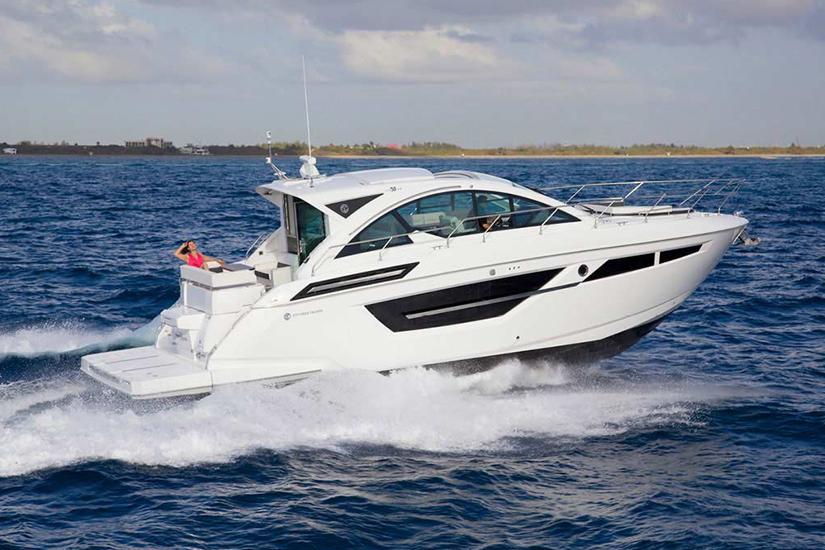
Most cabin cruisers can be towed with a trailer or flatbed (some require special permits in certain states) and can be stored on land in most boat yards and larger driveways. They are typically between 25 to 45 feet in length, although there are some as short as 17 feet, and some as long as 50 feet that may still be called cruisers (although the larger models are often referred to as motor yachts). Typically what differentiates a cabin cruiser from a full blown motor yacht is that cruisers tend to have a sleeker more aerodynamic look, a simpler interior layout with a single-level of living space and only one control station (although some may have a small, optional flybridge station). Many boaters choose cruisers as a practical option for long-distance boating trips due to their efficiency, comfort and relative ease of operability.
Newer Model Cabin Cruisers
Modern cabin cruisers tend to have the shorter “cruisers” label, or will often be called “express cruisers” meaning they have an open back to their cabins, usually covered with removable canvas, plastic or glass. They are usually equipped with some level of ventilation including heating, air conditioning, fans or water heaters. They also generally have an onboard galley, berths (beds), head (toilet), power generators and electrical systems – all of which make them ideal for spending extended periods of time on the water cruising.
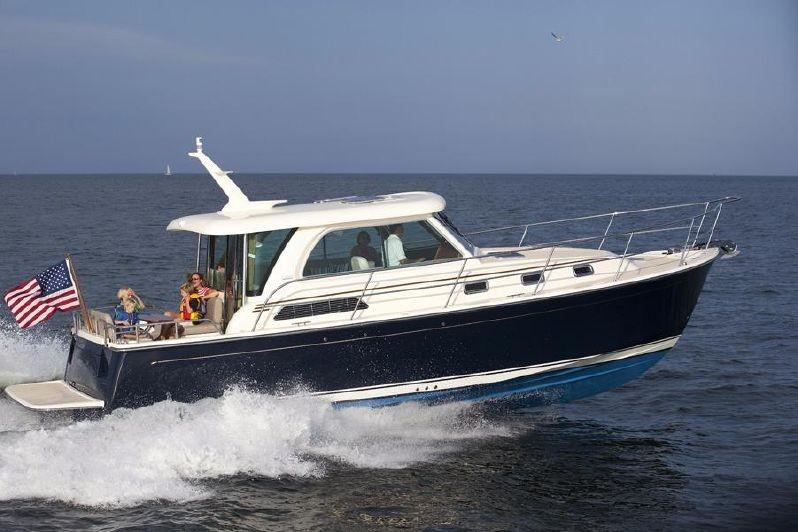
Cruisers are never sailboats (that’s a different class of boat, often referred to as “bluewater cruisers“), but a few may have steading sails for stabilization in rolling waves on large lakes and oceans (these can be called motor sailers and blur the line with power cruisers). Some cabin cruisers have stabilizers or fins that move through the water outside of the boat.
It’s important to note that unlike houseboats, cabin cruisers are not made to sit, without ever leaving a harbor or anchorage. Cruisers that are not used tend to lose their boat value far more quickly than those that are used frequently, because they will deteriorate and become inoperable from disuse. Instead these boats are built to be used like minivans or campers, and more modern models have been pushing the envelope for innovative use of space featuring multi-purpose design features. Ranger Tugs, Cutwater Boats, Jeanneau, Nimbus and Axopar are some of the names that are extending the concept of compact cruising boats to new realms.
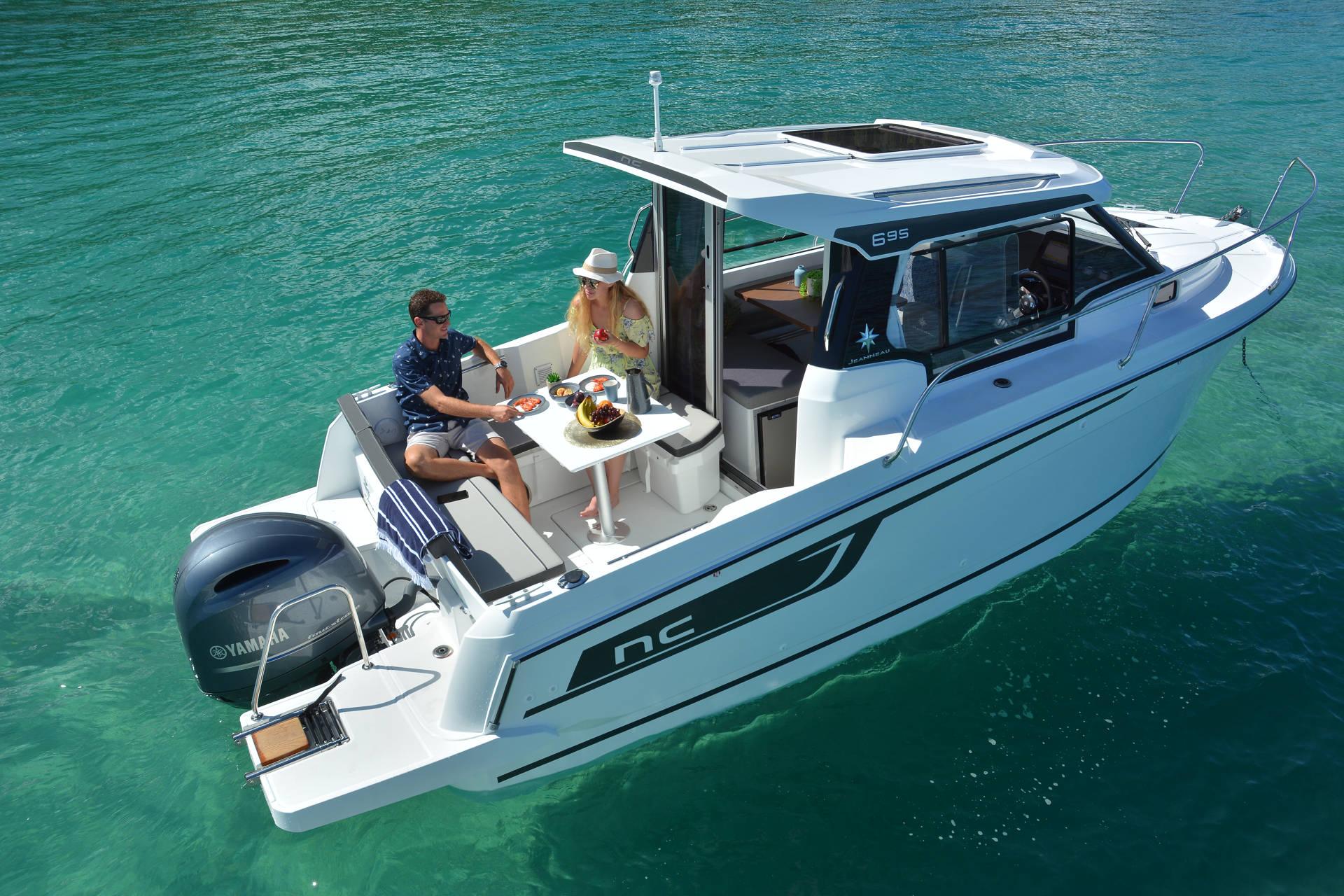
Thanks to advancements in outboard propulsion, more compact electronics and stronger, lighter weight materials in today’s boat building industry – such as carbon fiber, Kevlar and Vinylester – cruisers have become more advanced. They are now even more “trailerable” and easier to transport, maneuver and handle and are generally far more innovative in their use of onboard space. In fact there are so many different materials being used that a degree in chemical engineering is helpful when reading the brochure for a new boat! A lot of the research and development that has lead to these advancements came from the aircraft and aerospace industries, where strength and weight are primary concerns.
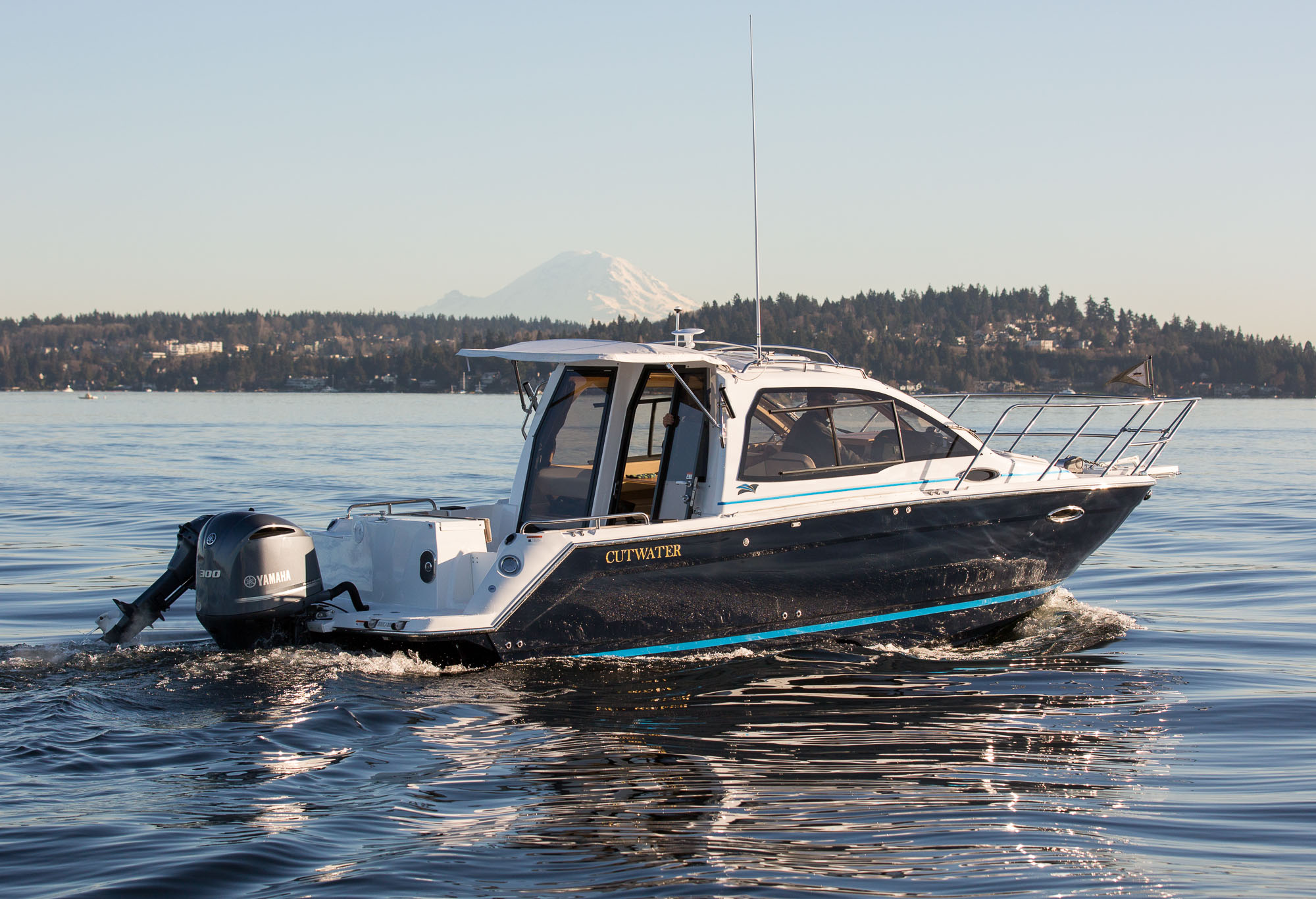
A History Of Cabin Cruisers: Personal Cruising Adventures
Now that we’ve covered what cabin cruisers are and taken a look at some of the newer models, let’s walk through some of my own experiences onboard my family’s cabin cruisers over the years, which will help illustrate the evolution of cruisers over the past few decades.
Our First Cabin Cruiser: “Seawon I” – 1968 to 1972
In 1968, my wife and I started out with our first cabin cruiser. She was a 17-foot, aluminum-hull Starcraft outboard cruiser with a small cuddy cabin for two and a removable pail for fluid wastes. (See Starcraft boats for sale on BoatTrader). As stated above, this is on the smallest end of the spectrum for a cabin cruiser boat. Back in the late 1960s, the small and mid-size cabin cruiser market was not as developed as today’s market, and this cuddy cabin boat really served our purposes for what we needed in a cruising boat that had a sleep-able cabin onboard. With the canvas up and sealed, she became essentially a full blow cabin cruiser. It was easy to cruise up to 100 miles per day at an average 20 miles per hour. Her full cover kept the rain out and my wife and I protected from the inevitable elements we encountered, and we slept in sleeping bags in the forward cuddy. Our young four-year-old slept on the seat at the stern and our collie was happy on the floor.
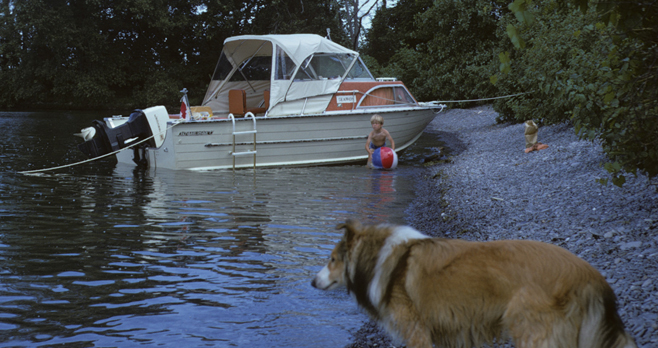
Our first long-distance boat trip was a two-week journey in Ontario – from Brockville (our home port) through the Thousand Islands, over to Trenton and then Northwest on the Trent Severn waterway. We cruised the Georgian Bay Islands where we tied the boat up beside an outcropping on a small uninhabited island and enjoyed some sandwiches.
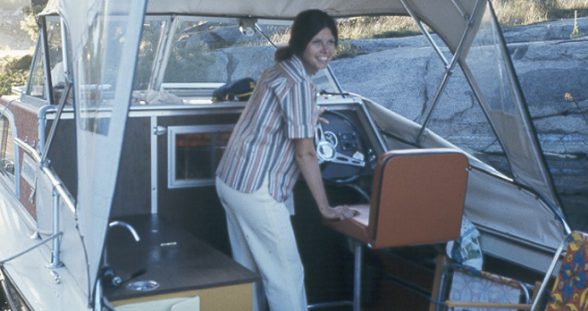
One night we tied up to a small houseboat anchored in a bay and became friends with the owners within a few minutes. One of the most important cruising lessons we learned that night was: it’s not the boats you meet, but the lifelong friends you’ll make.
Our Second Cabin Cruiser: “Seawon II” – 1972 to 1978
By 1972, we had two boys and needed more space aboard. A friend at our yacht club offered us his 26-foot Norwegian-built cruiser with twin sterndrive engines. It was the most beautiful design I’d ever seen – with a bar, v-birth, dinette and head with sink. The helm was on the deck, which sat over the galley, and the controls were still technically “open-air” as opposed to more sedan-style cabin cruisers, but we had a full top that covered from the helm back to the end of the aft deck, making her more of a true cabin cruiser.
There was a pass-through to the dinette, but most of the time we had meals on a large folding teak table and a full width padded chair across the back. We generally paired with others on our cruises and did another visit to Georgian Bay.
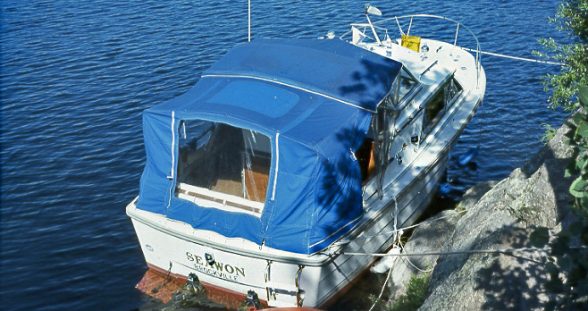
On one trip, we were accompanied by a 30-foot Bertram Yacht, where we cruised 250 miles together in rough waves on Lake Ontario, over to the Toronto harbor. We found that taking waves on the bow was much more comfortable than taking the waves on the side, across the beam.
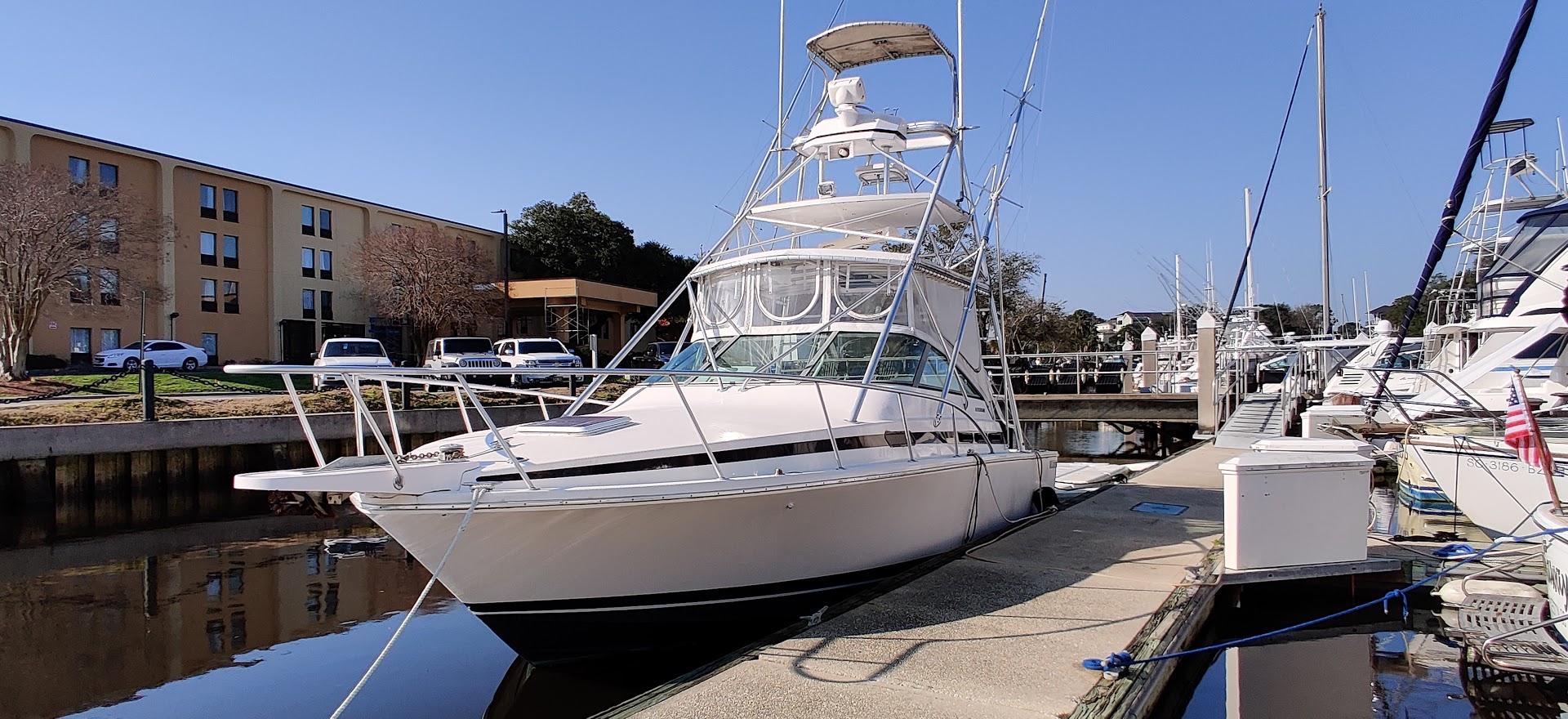
Sadly all boating came to an end for us in 1978, when I was transferred to Nashville, Tennessee. I took one look at the muddy Cumberland River and we spent a day on a 20-foot cruiser on Center Hill Lake (with no air-conditioning) and concluded it was not the boating life for us. Thus began a hiatus from boating that lasted over 20 years.
Our Third Cabin Cruiser: “Katy Leigh” – 1999 to 2017
By 1999 our kids were grown up, our business was doing well and we decided it was time to get back into boating – this time with a significantly bigger cabin cruiser! So we purchased a 36-foot 1981 Grand Banks Trawler and named her Katy Leigh. While trawlers are distinct in that they are designed for living aboard for long stretches and “sipping” fuel to make them more efficient, small to mid-size trawlers are also “cabin cruisers” because you spend most of the time cruising inside the cabin. Larger trawlers will bridge the gap from cabin cruisers to motor yachts, which the 36-foot Grand Banks does, straddling the line between those larger vessels while still remaining compact enough to easily maneuver and handle. (See Grand Banks boats for sale on BoatTrader).
The Perfect Great Loop Cruising Boat
With roots in commercial fishing trawlers, the Grand Banks interior was designed for living. We really wanted to do the Great Loop route that we’d been reading about for years, so this boat was a perfect fit. For those that don’t know, the Great Loop is the 5,500-mile circumnavigation of Eastern North America by water. It is the ultimate dream of many cruisers!

I bought the boat in Erie PA in April 1999 and we headed straight out onto Lake Erie, heading West into some fairly big waves. What I didn’t know at the time was that the waves were churning up old dirt in the fuel tanks (the vessel had been sitting for a while), which caused our fuel filters to clog and resulted in the engine quitting on us. My son was onboard with us and he tried to install new filters but had to give up as the rolling motion made him seasick. Finally, I dropped the anchor which reduced the rolling and we called the U.S. Coast Guard to rescue us.
Upon placing the call, I learned that all the marinas in the area had closed for the season. The Coast Guard said they had to tow us 20 miles or so to the nearest harbor who could accommodate our vessel. When we arrived at the harbor, the owner of the marina was ready for us, and he helped us tie up for the night.
The next day the contaminated dirty diesel fuel was pumped out of our tanks, and fresh diesel was installed. I learned two important lessons from this incident: 1) never go out on the boat with dirty fuel filters, and 2) don’t go out if the marinas nearby are not open.
Ongoing Yacht Maintenance While Cruising “The Loop”
For those that travel along the great loop (“loopers” as they are known) yacht maintenance is an ongoing saga that will inevitably present challenges along your cruising adventures. For us, a third and more complex fuel issue was soon discovered on our initial trip: not all the fuel that went through the engine was burnt up, and unfortunately, that unused fuel went straight back to the starboard tank. If the valves are improperly open (which they were), the unused fuel inadvertently got mixed with the fresh fuel from both tanks and contaminated the main fuel source.
After fixing all of these issues, our cruiser went the rest of the cruising adventure without incident – all the way up to a Detroit Marina. There we were supposed to get everything else we’d found on the first journey fixed up. We left the boat for a month and eventually returned in May to discover the service department at the marina had diagnosed a new driveshaft was required. Needless to say, this had to be custom-fabricated and installed, so we had to delay our planned trip.
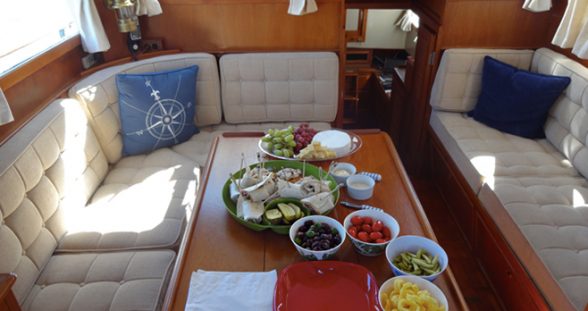
While we waited, we decided to stay onboard the boat and use the 15-gallon waste tank. When it filled up, I had to remove it and carry it to the washroom. After a while we decided we had enough of that lifestyle and went to a nearby hotel to await the repair. This turned out to be another mistake – horrible centipedes sped all around the floor at night that scared the life out of us.
Finally, the repair was complete, and we headed on our way.
Avoid Bridge Clearance Disasters: Know Your Air Height
The next leg of our trip ended up having two more major incidents. On the way down the Illinois River, the water was very high and the locks were wide open, so we flew right along. The gauges on the water depth could not be read, and the height of one bridge could not be determined accurately. At one bridge we came across, I went up on the flybridge and estimated we had enough clearance to make it through. As it turns out, I was wrong.
Unfortunately we hit the bridge and dragged our mast down six inches or so, to the port side. The mast light was smashed and we sustained additional minor damage. We did what we could to put the mast back up, eventually reaching the Mississippi River midday. What we learned here was that simply knowing your air height (i.e. minimum bridge clearance height) is sometimes not enough when you can’t read the markings on the bridge. In this case, take it from experience – do not risk a passing if you are unsure.
After that ordeal, we decided to go into the harbor at St. Genevieve which had lots of water, where we tied up for the night and enjoyed a dockside dinner, then walked to town.
The next morning, we left early and had planned to stop at a harbor of sorts – at the Ohio River junction. When we arrived, I didn’t like the look of the harbor. The air-conditioning was not working and a captain friend (who was along with us for a stint), suggested we head upstream to Paducah and dock there.
Finding Marinas Along The Way
When we arrived in Paducah we discovered the dock had been wiped out. We slowed down in the Ohio River to make dinner and were suddenly hit with a violent storm that reduced vision to zero. The wind was so strong it knocked the dinghy off the mounts and onto the deck.
For the next hour, I managed to use our 1981 radar to keep us on the river during the storm, going around in circles to avoid coming too close to other boats and the treacherous shore. The rain eventually cleared and we were able to head up the Tennessee River to the lock at Kentucky Dam. The dockmaster said we would have to wait until 3:00 AM because of other traffic.
Finally, the dockmaster let us tie up to the bollards at the lock entrance. This was a relief as there is no way you can get an anchor to hold in the river and we kept drifting. After a time, he opened the lock and we chose a bollard in the middle of the lock, which was another big mistake. Here we learned another valuable lesson: never choose a position in the lock without first consulting the lock master. The middle of that particular lock had such violent currents, it was all we could do just to hang on.
After that, we enjoyed a glorious moment out on Kentucky Lake. Our plan was to dock at the Kentucky Dam Marina, but there were no empty slips. So we had to manage with just a short nap on anchor and then move on. We decided to keep going 22 miles further to Kenlake Marina, which was our final stop.
We got there at 7:00 AM, had a great breakfast, and were guided to our slip where we immediately fell asleep until the afternoon. That trip was at an end, and we’d completed one-third of the Great Loop.
Completing The Great Loop: Two Years Of Cruising Adventures
We spent the next two years making our plans to do the rest of the Great Loop. We planned to do it in four stages starting in 2003 down in Florida in the Fall. We figured we’d make it up to the Chesapeake Bay by the early spring, Oxford Yacht Agency in the Fall of 2004, and Winter Harbor in the winter. Then we would do the Great Lakes and back to Kentucky Lake by the end of June 2005.
Each time we stopped for a break we had major work done on the boat. Work included: Teak rails, new bottom, bow thruster, new outside hull paint, new Bimini canvas, cracked windows replaced and new heads and larger holding tanks. As we learned, it is very important to keep up with all of this maintenance as you use the vessel.
I won’t get into all the details of that trip. Suffice to say, we had all the major bugs eliminated and I knew far more about boating than the previous trips we’d taken around the Tennessee River and the Cumberland River. After finishing the loop, we got new chart plotters, an AIS, rail mount barbecue, a new fridge, iron tanks cleaned, and many other “had-to-have” devices that I would suggest all long-term cruising boaters purchase.
After 2005, we had a system of opening the boat out on March 15 and closing it up on November 15. We winterized it every November 15, which I would also recommend every boater do – in order to preserve and extend the life of the vessel. This gave us a boating season that lasted eight months or two-thirds of the year. Most importantly, we made life long friends at both our marina and the other marinas on the lakes.
For a while, all was going well, until the owner of our marina passed away and left the business to his daughter who unfortunately had no interest in continuing the business. Eventually, all of our friends went to other marinas and my wife and I decided to sell the boat and start a new lifestyle. We hit upon the idea of going back to Brockville and buying a condo in the Tall Ships Landing that had recently opened.
For years we enjoyed the condo life, however, every day I looked out our ninth floor windows and watched the St. Laurence River, wishing I could be back out there cruising and relaxing. I realized we would have to buy a boat.
Our Fourth Cabin Cruiser: “Seawon III” – 2018 to Current
All through 2018, I studied the smaller cabin cruisers and eventually settled on a Limestone 24 cruiser. Ok, this is technically a “cuddy cabin” boat more than a cabin cruiser, but this boat would be big enough to handle the large waves that are often found in the area, yet small enough to trailer easily and simplify storage. That is a big concern for a lot of boat buyers when they are looking for the right cabin cruiser boat, i.e. how easy will she be to trailer? While I found a Limestone 24 in a harbor nearby, it was unfortunately not for sale. (See Limestone boats for sale on BoatTrader). I did however get a nice ride on it and was convinced it was the right cruiser for me. Then in December, I discovered the Rossiter 23 in a magazine and it looked even better than the Limestone.
This boat had an outboard engine, a swim platform and nine comfortable seats for passengers. Again, she really isn’t quite a “true cabin cruiser” but her small cuddy cabin had a real toilet with a freshwater pump, a holding tank and best of all – no pail like Seawon I! So it fit the bill for our needs. The build-quality was outstanding and in the same league as the Hinckley Picnic Yachts, in my opinion. The Rossiters are made in Canada in Ontario and the local Hucks is the dealer that sold me the first Seawon 51 years earlier. (See Rossiter boats for sale on BoatTrader).
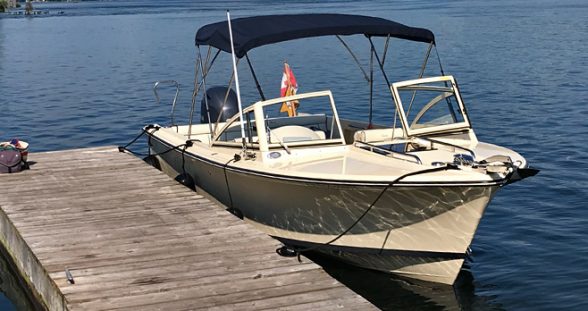
They call the Rossiter 23 a classic day boat. There were no used boats on the market that I could find – only new boat models. Of course, the advantages of buying a new boat are that you get to pick your options! For example, I saw no need for headlights. They just get in other boaters’ eyes when you approach at night. What I did need was what I called a “Geezer Support”. They didn’t like that name for marketing purposes – they call it “Starboard Passenger Assist.” Call it what you may, but it’s very valuable for people with any kind of balance problem trying to board the boat! Rossiter boats are made in Markdale, ON, near Owen Sound and Georgian Bay, so it’s an area I know well from Seawon I and II.
I ordered the cruiser in January and it was delivered in mid-June. I spent all day on June 17th with the Rossiter CEO and a dealer, who wanted to see that everything was functioning properly. We did a sea trial cruise on the river and everything was in perfect condition. The next day a friend helped me move the boat about 20 miles to the Brockville Yacht Club.
Docking An Outboard Vs Inboard Boat
Because of the trash in the river, we cruised at 10 miles per hour and got to the club without incident. However, I did have some problems with docking the boat in such a tight space. I learned another valuable lesson: docking an outboard powered boat is a lot different than docking an inboard powered boat like our Grand Banks. I decided to take two lessons, and now I’m able to dock perfectly.
There are so many things to learn about boating that it keeps me busy – reading books, testing out various things and snoozing in the cabin. Life has been good to us, and I expect to get a few more years with the Seawon III before giving up again for good.
Frequently Asked Questions
What’s the difference between a cabin cruiser and a yacht?
Cabin cruisers are boats that are designed for passengers to ride on inside the cabin, with a protected helm and some level of accommodations and amenities onboard. Larger cabin cruisers can fall under the category of “yachts”, although they generally do not require a professional yacht crew and can be operated by a single captain. Due to their size and design they can offer many of the same amenities as larger motor yachts including a stable ride in open water. However, they can be small enough to trailer (an advantage over bigger motor yachts) and maneuverable enough for small harbors and marinas, while still providing enough room for couples and families to live aboard on cruising adventures.
What are the best cabin cruiser boat brands?
Some of the best-known cabin cruiser boat manufacturers are: Cruiser Yachts, Four Winns, Sea Ray, Tiara, Aspen, Pursuit, Riva, Sabre, Hunt, Prestige and Grand Banks, to name a few. Visit Boat Trader to see a complete list of Cabin Cruiser Brands and Boats For Sale for sale.
How much does a cabin cruiser weigh?
Cabin cruisers generally weigh around 150 lbs per foot, dry-weight. Of course a vessels can weigh substantially more with full gas tanks, fluids, ballasts equipment, food, supplies and passengers.
Editor’s Note: This article was originally published in August 2019, but was rewritten and last updated in March 2022 to reflect new models on the market.


0 Comentarios